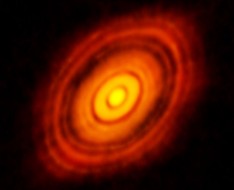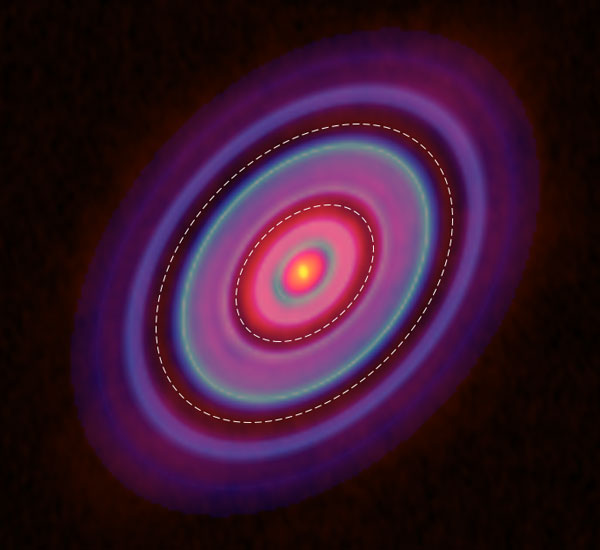Astronomers re-analyzed two-year-old data from the ALMA observatory in Chile and discovered gas gaps that probably indicate baby planets in the disk around a young star.

ALMA (NRAO/ESO/NAOJ) / C. Brogan / B. Saxton
Two years ago, the Atacama Large Millimeter/submillimeter Array (ALMA) captured a stunning image of planetary genesis around a young star named HL Tauri, 450 light-years away. Incredibly, even though the star is only a million years old — a stellar infant on astronomical time scales — its disk showed unmistakable gaps.
The disk spans 235 astronomical units, where an a.u. is the distance between Earth and the Sun. A large gap can be seen in the dusty disk at around 32 a.u.; another two gaps can be seen at 64 and 74 a.u. Later simulations suggested that giant planets, though less massive than Jupiter (read: too small to be visible), would be enough to plow these grooves in the dust.
But forming even a mini-Jupiter ought to take more than tens of millions of years, at least according to the standard theory of core accretion, where a rocky core attracts a thick envelope of gas over time.
Then again, not every disk gap contains a planet. Theorists were quick to offer non-planet suggestions for HL Tau’s rings. As pebbles or larger dust particles built up in the disk, for example, they could sweep up smaller dust particles, creating apparent gaps at 1.3 millimeters, the wavelength at which the cool dust glows. But these gaps would nevertheless still be filled with stuff — just not stuff that radiates at 1.3 millimeters.
Now, a team led by Hsi-Wei Yen (Academia Sinica Institute of Astronomy and Astrophysics, Taiwan) has re-analyzed the data captured two years ago to look at the disk’s gas rather than its dust. If the gaps were due simply to a change in the size of dust grains, then gas ought to fill the gaps.
When astronomers looked at the original ALMA image, the emission from the gas in the disk wasn’t seen at high enough resolution to make out whether gas fills the gaps. But Yen’s team tackled the data in a different way: they drew rings around the star and summed up any gas emissions within each ring.

ALMA (ESO / NAOJ / NRAO), Yen et al.
Their new image reveals that the gaps at 30 a.u. and 70 a.u. are clear, through and through. The result isn’t a smoking gun, the authors admit, but it’s still awfully good evidence that planets probably live in these gaps. And from the width of the gas gaps, the authors can even predict the size of the planets that could have carved them: the inner one might host a planet 80% of Jupiter’s mass, while a planet about twice Jupiter’s mass might live in the outer gap.
If young HL Tau hosts planets, it’s not alone: Christopher Johns-Krull (Rice University) and colleagues just discovered a planet roughly 11 times Jupiter’s mass around a neighboring star, CI Tau. This 2 million-year-old star lives in the same star-forming complex as HL Tau, and it’s also far too young to be hosting a giant planet.
These discoveries leave the ball in the theorists’ court, because the big question is still unanswered: how could massive planets have formed in such a short time?
 2
2









Comments
Peter Wilson
June 2, 2016 at 9:59 am
I am confused as to why there is a mystery. With the cloud-collapse that leads to star formation being both chaotic and fractal, how do theorists know the massive planets circling it did not form at the same time as HL Tauri itself?
If it was a binary star, would we not assume both parts formed at the same time? How do theorists know the disc surrounding it was smooth and featureless until the starting-gun was fired?
You must be logged in to post a comment.
June 5, 2016 at 11:32 am
Could a giant planet like the one around CI Tau continue to gain mass and develop into a star?
You must be logged in to post a comment.
You must be logged in to post a comment.